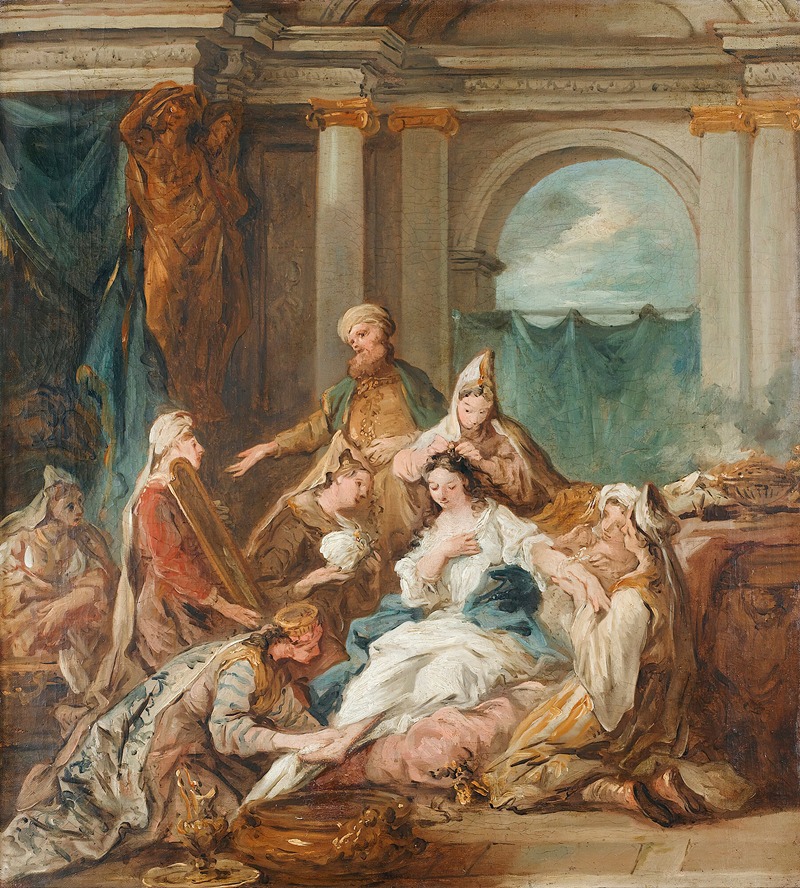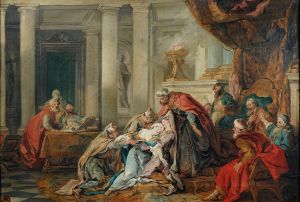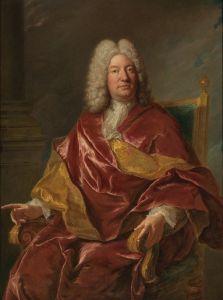
Esther at her toilet
A hand-painted replica of Jean-François de Troy’s masterpiece Esther at her toilet, meticulously crafted by professional artists to capture the true essence of the original. Each piece is created with museum-quality canvas and rare mineral pigments, carefully painted by experienced artists with delicate brushstrokes and rich, layered colors to perfectly recreate the texture of the original artwork. Unlike machine-printed reproductions, this hand-painted version brings the painting to life, infused with the artist’s emotions and skill in every stroke. Whether for personal collection or home decoration, it instantly elevates the artistic atmosphere of any space.
"Esther at her Toilet" is a painting by the French artist Jean-François de Troy, created in the early 18th century. Jean-François de Troy (1679–1752) was a prominent Rococo painter known for his historical and mythological scenes, as well as his depictions of contemporary life. He was a member of the prestigious Académie Royale de Peinture et de Sculpture and served as its director.
The painting "Esther at her Toilet" depicts a scene from the biblical story of Esther, a Jewish queen of the Persian king Ahasuerus (Xerxes I). The story of Esther is recounted in the Book of Esther in the Hebrew Bible and the Old Testament. Esther is known for her beauty and her bravery in saving the Jewish people from a plot to destroy them, orchestrated by the king's advisor, Haman.
In the painting, Esther is shown preparing herself, likely for an important event or meeting. The term "toilet" in this context refers to the process of dressing and grooming. The scene captures a moment of intimate preparation, highlighting Esther's grace and elegance. The composition typically includes attendants or maids assisting her, emphasizing her royal status and the care taken in her appearance.
Jean-François de Troy's style is characterized by its elegance, attention to detail, and the use of vibrant colors. His works often reflect the luxurious and ornate qualities of the Rococo period. In "Esther at her Toilet," de Troy employs soft, flowing lines and a delicate color palette to create a sense of refinement and sophistication. The painting's composition and the depiction of fabrics and textures demonstrate de Troy's skill in rendering intricate details.
The painting is notable for its portrayal of a strong female figure from a historical and religious narrative, a theme that was popular in 18th-century European art. Esther's story of courage and wisdom resonated with contemporary audiences, and her depiction in art often served as a moral and inspirational example.
"Esther at her Toilet" is part of the collection of the Musée des Beaux-Arts in Orléans, France. The museum houses a diverse collection of artworks, including pieces from the Renaissance to the 19th century. Jean-François de Troy's works are appreciated for their contribution to the Rococo movement and their depiction of both historical and everyday scenes with elegance and charm.
This painting is an excellent example of de Troy's ability to blend historical narrative with the aesthetic qualities of the Rococo style, making it a significant piece in the study of 18th-century French art.















